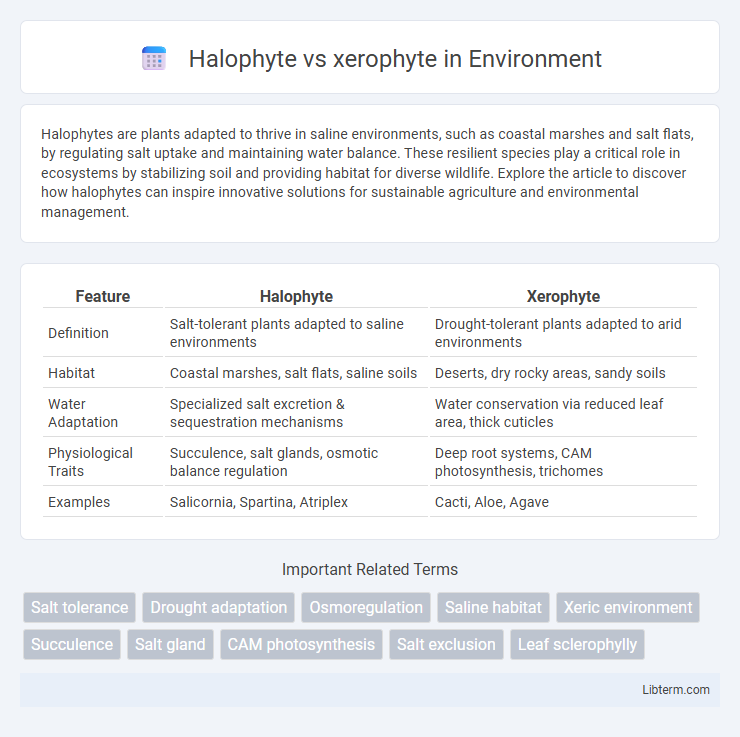Halophytes are plants adapted to thrive in saline environments, such as coastal marshes and salt flats, by regulating salt uptake and maintaining water balance. These resilient species play a critical role in ecosystems by stabilizing soil and providing habitat for diverse wildlife. Explore the article to discover how halophytes can inspire innovative solutions for sustainable agriculture and environmental management.
Table of Comparison
| Feature | Halophyte | Xerophyte |
|---|---|---|
| Definition | Salt-tolerant plants adapted to saline environments | Drought-tolerant plants adapted to arid environments |
| Habitat | Coastal marshes, salt flats, saline soils | Deserts, dry rocky areas, sandy soils |
| Water Adaptation | Specialized salt excretion & sequestration mechanisms | Water conservation via reduced leaf area, thick cuticles |
| Physiological Traits | Succulence, salt glands, osmotic balance regulation | Deep root systems, CAM photosynthesis, trichomes |
| Examples | Salicornia, Spartina, Atriplex | Cacti, Aloe, Agave |
Introduction to Halophytes and Xerophytes
Halophytes are salt-tolerant plants adapted to thrive in saline environments such as coastal marshes and salt flats, utilizing specialized mechanisms like salt excretion and succulence. Xerophytes, in contrast, are drought-resistant plants found in arid regions with minimal water availability, employing adaptations like thick cuticles, reduced leaf surface area, and deep root systems. Both halophytes and xerophytes exhibit unique physiological and structural traits enabling survival under extreme environmental stress, making them crucial for ecological balance and land rehabilitation.
Defining Halophytes: Adaptations to Salinity
Halophytes are plants specially adapted to thrive in high-salinity environments such as salt marshes and coastal areas, exhibiting unique physiological and structural mechanisms to manage salt stress. These adaptations include salt excretion through specialized glands, succulence to dilute internal salt concentration, and selective ion uptake to maintain cellular homeostasis. Unlike xerophytes, which primarily adapt to water scarcity, halophytes focus on mitigating the toxic effects of excess salt while maintaining growth and reproduction.
Understanding Xerophytes: Survival in Dry Environments
Xerophytes exhibit specialized adaptations such as thick cuticles, reduced leaf surface area, and deep root systems to conserve water and thrive in arid environments. These plants employ mechanisms like CAM photosynthesis and stomatal regulation to minimize water loss while maximizing carbon dioxide intake. In contrast to halophytes, which tolerate saline conditions, xerophytes primarily survive drought with structural and physiological traits tailored to dry habitats.
Key Differences Between Halophytes and Xerophytes
Halophytes are plants adapted to saline environments, exhibiting specialized salt-excreting glands and succulent leaves for salt regulation, while xerophytes thrive in arid conditions with features like deep root systems and thick cuticles to minimize water loss. Halophytes often inhabit coastal or salt marsh areas, contrasting with xerophytes found in deserts and drylands. Water management strategies differ significantly, with halophytes managing salt stress and xerophytes optimizing water conservation.
Habitat and Distribution Patterns
Halophytes thrive in saline environments such as coastal marshes, salt flats, and mangrove swamps, predominantly found in regions with high soil salinity like salt deserts and tidal zones. Xerophytes are adapted to arid and semi-arid habitats including deserts, rocky terrains, and dry shrublands, commonly distributed across parts of Africa, Australia, and the southwestern United States. Both plant types exhibit specialized adaptations that allow survival in extreme environmental conditions with limited water availability or high salt concentrations.
Physiological Adaptations and Mechanisms
Halophytes exhibit specialized physiological adaptations such as salt excretion glands, succulence for ion dilution, and selective ion uptake to thrive in high-salinity environments. Xerophytes adapt by minimizing water loss through thick cuticles, sunken stomata, and CAM photosynthesis, allowing survival in arid conditions. Both plant types optimize water use efficiency but through distinct mechanisms suited to saline versus drought stress.
Examples of Halophyte and Xerophyte Species
Salicornia and Avicennia are notable examples of halophyte species thriving in high-salinity environments such as salt marshes and mangroves, respectively. Cacti, including species like the Saguaro (Carnegiea gigantea), and Agave are prominent xerophytes adapted to arid desert conditions with features minimizing water loss. These specialized plants exemplify evolutionary responses to extreme saline and dry habitats, highlighting their ecological significance.
Ecological Roles and Environmental Importance
Halophytes play a critical ecological role by stabilizing saline habitats and supporting biodiversity in coastal and salt-affected environments through salt tolerance mechanisms. Xerophytes contribute significantly to arid ecosystems by conserving water, preventing soil erosion, and sustaining food webs in deserts and dry regions. Both plant types enhance ecosystem resilience under extreme environmental stress, promoting habitat sustainability and soil health.
Agricultural and Economic Uses
Halophytes, salt-tolerant plants such as Salicornia and mangroves, play a crucial role in saline agriculture by enabling crop production on salt-affected soils, supporting coastal aquaculture, and providing sources for biofuels, animal fodder, and pharmaceuticals. Xerophytes like cacti and agaves are economically valuable in arid regions due to their drought resistance, serving as sources of fiber, food, bioenergy, and erosion control in desert agriculture. Both plant types contribute significantly to sustainable land use, resource management, and climate resilience in marginal environments.
Future Research and Conservation Strategies
Future research on halophytes and xerophytes should prioritize genetic studies to enhance stress tolerance mechanisms, enabling the development of resilient crops for saline and arid environments. Conservation strategies must focus on habitat restoration and creating seed banks to protect these plants from climate change and human activities. Integrating remote sensing technology and ecological modeling can improve monitoring and management of halophyte and xerophyte populations globally.
Halophyte Infographic

 libterm.com
libterm.com